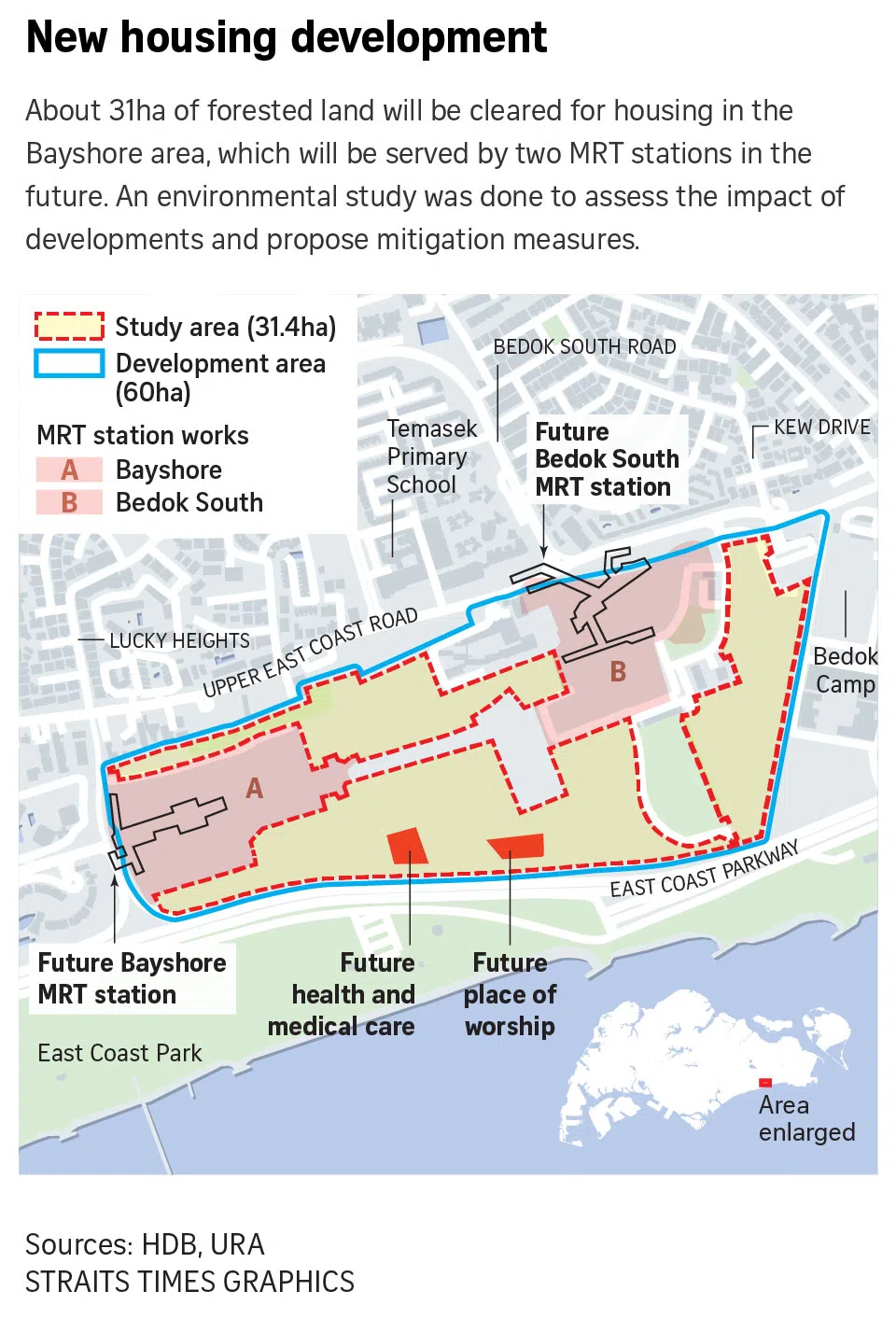31ha of forested areas in Bedok to make way for 10,000 new homes in Bayshore
Sign up now: Get ST's newsletters delivered to your inbox

An environmental impact study found the areas to be cleared for the upcoming Bayshore housing precinct are of "minor to moderate" conservation value.
ST PHOTO: LIM YAOHUI
Follow topic:
SINGAPORE – About 31ha of forested areas in Bedok are slated for clearance by 2029, to make way for the future Bayshore housing precinct
An environmental impact assessment report published by the Housing Board on Tuesday said the areas to be cleared are of “minor to moderate” conservation value, due to low species richness, a small proportion of species of conservation significance, and the dominance of non-native flora.
However, the report noted that the areas slated for clearance are among the last substantial forest fragments in eastern Singapore, and construction in the area will have irreversible impacts, especially due to the loss of habitats for plant and bird species.
The study by environmental consultancy DHI Water and Environment included baseline surveys conducted between April 25, 2022 and July 21, 2022, and covered 31.4ha of the 60ha development site, which is the equivalent of about 84 football fields in size.
The entire development site is bounded by Upper East Coast Road to the north, East Coast Parkway to the south, Bayshore Road and Bedok Camp. The portions not studied were largely vegetated sites that have since been cleared for ongoing MRT construction works.

The Urban Redevelopment Authority has previously showcased plans for Bayshore – including at June’s long-term plan review exhibition – which will be served by two future MRT stations on the Thomson-East Coast Line – Bayshore and Bedok South. The entire precinct is slated to provide 10,000 new homes, which will be a mix of public and private housing.
Housing projects in the area are likely to be ready in the mid- to late-2030s, based on that report which stated that site clearance works will take place in three phases. The first is slated to commence in 2023 and the entire site clearance is set for completion in 2029. Construction of housing will begin after site platform preparation works, with each project expected to take four to six years to complete, said the report.
The bulk of the study area is land reclaimed between 1966 and 1985. In terms of vegetation, a third was classified as scrubland and a quarter as reclaimed land vegetation, which is similar to secondary forests dominated by non-native species that made up a fifth of the surveyed area.
About half of the 196 flora species recorded are native, including 16 that are of conservation significance. As for fauna, 147 species were recorded, of which 54 were birds. Six bird species found were of conservation significance, such as the oriental magpie-robin (Copsychus saularis) and the blue-crowned hanging parrot (Loriculus galgulus).
The report said the development area is mostly low-lying, and will need to be raised to at least 4m Singapore height datum for flood protection purposes.
It added that planned site clearance will stop the regeneration process of native coastal understorey plants, and said the study area is a refuge for birds, which will lose foraging, roosting and nesting locations.
To mitigate these effects, the study recommended conserving flora species of significance by transplanting, harvesting their saplings or propagules, or taking stem cuttings. Clearance works should take place in a directional approach – from west to east, for instance – so animals can be shepherded out of the site to minimise injury or death.
Animal trapping and translocation will also be carried out, with emphasis on four species – the common palm civet (Paradoxurus musangus), the common tree shrew (Tupaia glis), the painted bronzeback (Dendrelaphis pictus) and the equatorial spitting cobra (Naja sumatrana).
Nature Society (Singapore) president Shawn Lum said it is a pity that a rare forested patch that has shown regeneration potential will be lost, but added that the study’s findings may yield lessons for providing green spaces in the east.

Housing projects in the area are likely to be ready in the mid- to late-2030s, based on that report which stated that site clearance works will take place in three phases.
ST PHOTO: LIM YAOHUI
Referring to the study area, which is largely isolated from other green spaces, he said: “It is remarkable how much stuff made it there despite the fact that the area is so built up – I think that’s pretty amazing.”
Dr Lum cited the sighting of the common tree shrew, which is usually found in secondary forests, and the sea olive, a species of conservation significance more commonly found in mature coastal forests, and said studying how these species ended up in Bayshore will give the authorities insights on how future green patches can be planned for and managed.
The Bayshore area, which was reclaimed for development but unintentionally became a “temporary green lung”, has shown through biodiversity surveys that healthy ecosystems can develop naturally, he said, urging the authorities to consider how similar pockets of green spaces can be inserted in the east, which is largely built up. These can create ecological links between forested areas in Paya Lebar Air Base and East Coast, and to the rest of the island, he said.
“Bayshore may be going, but there is enough runway to plan for and retain green spaces for the air base, as well as for possibly future coastal projects, that will benefit biodiversity, and Singaporeans’ mental health and recreation,” he said.
Members of the public can view the environmental impact assessment report on the HDB’s website, and have until Nov 29, 2022 to submit feedback at


